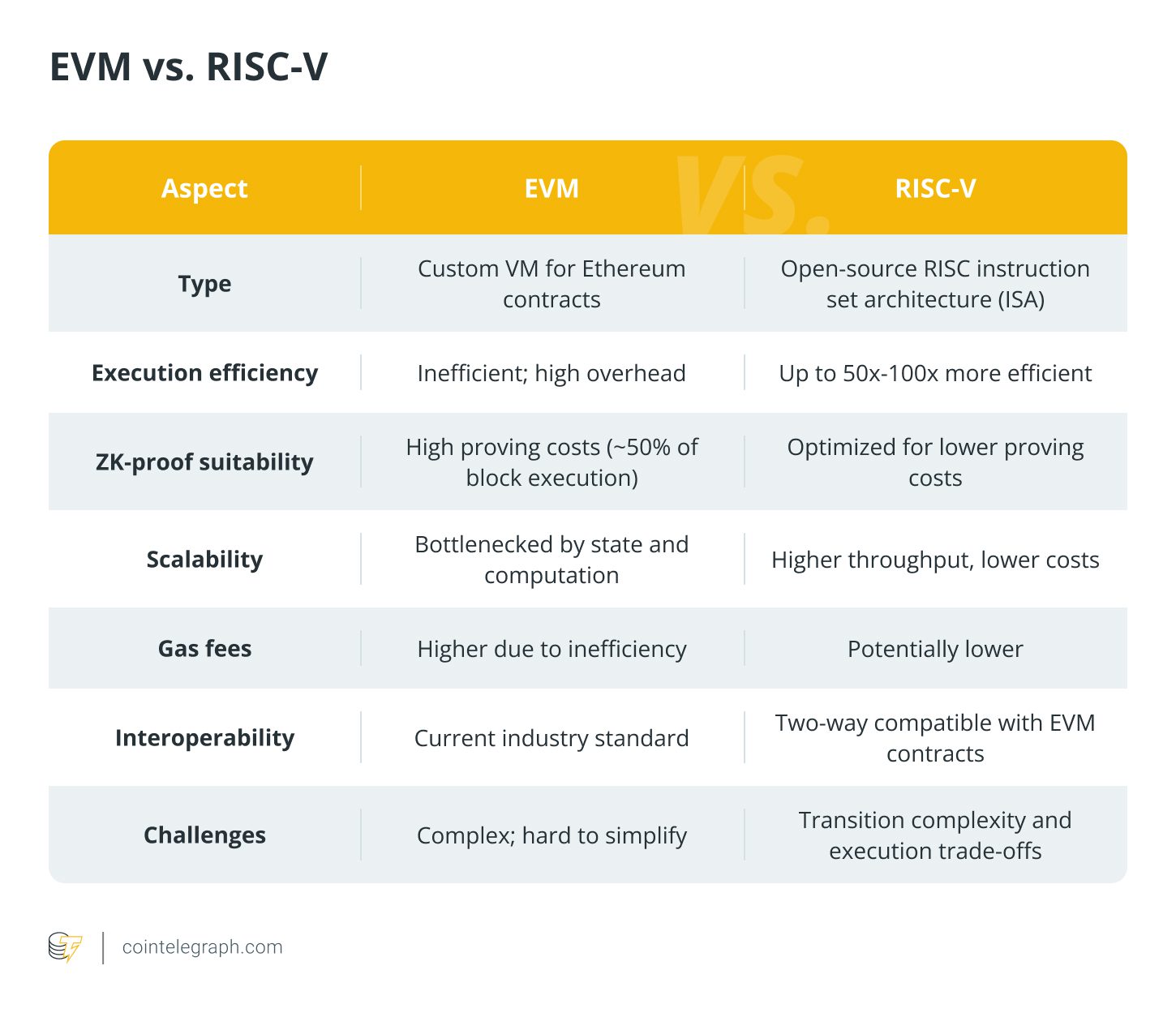What is RISC-V?
RISC-V (pronounced “risk five”) is an open-source instruction set architecture (ISA) based on reduced instruction set computer (RISC) principles. Think of it as a blueprint that defines the instructions a processor can execute. Its modular design offers flexibility and efficiency, making it suitable for various applications, including blockchain technologies like Ethereum.
Vitalik Buterin’s RISC-V Proposal for Ethereum
Ethereum co-founder Vitalik Buterin has proposed replacing the Ethereum Virtual Machine (EVM) with RISC-V architecture to boost the network’s speed and efficiency. The primary goal is to address Ethereum’s scalability limitations, which have led to high transaction fees and slower transaction processing.
How Would RISC-V Work on Ethereum?
Buterin’s proposal includes different approaches to integrating RISC-V into Ethereum:
- Dual Virtual Machines (VMs): Contracts can be written and executed in either the existing EVM or RISC-V. Both types of contracts would access functionalities like persistent storage and Ether (ETH) balances.
- Complete Switch to RISC-V: This approach converts existing EVM contracts by rewriting them to interact with a RISC-V interpreter. New contracts would be written directly in RISC-V.
A key challenge is to avoid disrupting existing decentralized applications (DApps) and smart contracts. A transitional solution could use an interpreter to ensure legacy EVM contracts continue to function without disruption.
Key Benefits of RISC-V vs. EVM
Switching to RISC-V could significantly improve Ethereum smart contracts’ performance and processing. Potential benefits include:
- Efficiency Gains: RISC-V could deliver efficiency gains up to 100x, especially when combined with zero-knowledge (ZK) proof systems, which eliminate EVM overhead.
- Lower Gas Fees: Faster, more efficient smart contracts could reduce gas fees for end users.
- Improved Scalability: The network could handle more users and transactions without slowing down.
- Better ZK-Proof Computations: RISC-V’s flexible instruction set is better suited for ZK-proof computations than the EVM.


Potential Drawbacks and Community Concerns
The RISC-V proposal has sparked debate within the Ethereum community. Concerns include:
- Block Building and Execution: Switching to RISC-V could potentially slow down block building and execution, offsetting the gains from ZK-proof improvements.
- EVM Optimization: The EVM is highly optimized for U256-based operations, and abstracting down to RISC-V could decrease overall execution performance.
- Technical Difficulty and Cost: Implementing RISC-V would be a complex and costly endeavor, requiring significant technical resources.
Will RISC-V Be Implemented in the Future?
Buterin’s proposal is under consideration, and the Ethereum community is actively discussing its potential impact. The green light depends on community consent and addressing the technical challenges. While RISC-V promises radical simplification and efficiency, it also introduces a complex technical change that requires careful planning and execution.
Understanding Instruction Set Architectures (ISAs)
An Instruction Set Architecture (ISA) is a fundamental component of computer architecture, defining the instructions that a CPU can understand and execute. It is essentially the interface between the hardware and software layers. ISAs can be broadly categorized into two types: Complex Instruction Set Computing (CISC) and Reduced Instruction Set Computing (RISC).
CISC architectures, like Intel’s x86, use a large and complex set of instructions. These instructions can perform multiple operations at once, aiming to minimize the number of instructions needed to execute a program. However, this complexity often leads to longer execution times and more power consumption.
RISC architectures, on the other hand, use a smaller, simpler set of instructions. Each instruction performs a single operation, and programs are executed by combining these simple instructions. This simplicity leads to faster execution times, lower power consumption, and easier hardware implementation.
The Significance of Open-Source ISAs
Proprietary ISAs like ARM and x86 are controlled by specific companies, which charge licensing fees for their use. This can be a barrier to entry for smaller companies and research institutions.
Open-source ISAs like RISC-V offer several advantages:
- No Licensing Fees: Anyone can use RISC-V without paying licensing fees, which reduces costs and encourages innovation.
- Customization: RISC-V can be customized to fit specific application needs, which is not possible with proprietary ISAs.
- Transparency: The open-source nature of RISC-V allows for greater transparency and security.
- Collaboration: The open-source community can collaborate on improving RISC-V, leading to faster development and better performance.
RISC-V Beyond Ethereum: Other Potential Use Cases
While Vitalik Buterin’s proposal focuses on using RISC-V to enhance Ethereum’s performance, the architecture has a wide range of other potential use cases:
- Embedded Systems: RISC-V’s low power consumption and small size make it ideal for embedded systems like IoT devices and wearables.
- High-Performance Computing: RISC-V’s simplicity and scalability make it suitable for high-performance computing applications like supercomputers and data centers.
- Artificial Intelligence: RISC-V can be used to accelerate AI workloads like machine learning and deep learning.
- Aerospace and Defense: RISC-V’s robustness and security make it suitable for aerospace and defense applications.
The Future of RISC-V
RISC-V is still a relatively new architecture, but it has already gained significant momentum in the industry. The RISC-V Foundation, a non-profit organization that manages the architecture, has over 2,000 members, including major tech companies like Google, Nvidia, and Qualcomm.
As RISC-V continues to evolve and mature, it is likely to become an increasingly important part of the computing landscape.